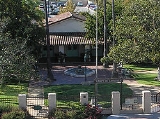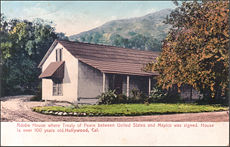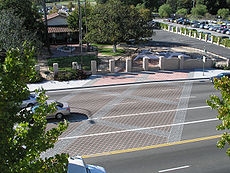
Campo de Cahuenga
Encyclopedia
The Campo de Cahuenga, near the historic Cahuenga Pass
in present day Studio City, Los Angeles, California
, was an adobe
ranch-house on the Rancho Cahuenga
where the Treaty of Cahuenga
was signed between Lieutenant Colonel John C. Frémont
and General Andrés Pico
in 1847, ending hostilities in California between Mexico
and the United States
. The subsequent Treaty of Guadalupe Hidalgo
of 1848, ceding California, New Mexico, and Arizona (but not Texas, since it had seceded from Mexico in 1836, declared itself a republic, and joined the union in 1845) to the United States, formally ended the Mexican-American War. From 1858 to 1861 the Campo de Cahuenga became a Butterfield Stage Station
.

 The original adobe structure was demolished in 1900. The city of Los Angeles
The original adobe structure was demolished in 1900. The city of Los Angeles
provided funds for the purchase of the property in 1923, and a Mission Revival
and Spanish Colonial Revival style replica 'adobe' ranchhouse was built by the city following an effort led by Irene T. Lindsay, then President of the San Fernando Valley Historical Society
, was dedicated on November 2, 1950. It is now a park and interpretive center managed by the City of Los Angeles- Department of Recreation and Parks in partnership with the Campo de Cahuenga Historical Memorial Association. Campo de Cahuenga is registered on the National Register of Historic Places
, and is designated California Historical Landmark
No. 151 and City of Los Angeles City Cultural Historical Monument No. 29.
The foundations of the original adobe were unearthed beneath Lankershim Boulevard during construction of the Metro Red Line
subway. The parts of the foundations within the park are preserved as an exhibit, and the "footprint" of the foundations under the street and sidewalk is marked by decorative pavement.
Campo de Cahuenga is located at 3919 Lankershim Blvd., Studio City, California, across from Universal Studios.
Campo de Cahuenga is often confused with the nearby Rancho Cahuenga
, an inholding within the Rancho Providencia
land grant, now part of Burbank
.
The building is used by various organizations for special programs and regular meetings, and is open with a docent on Saturdays.
Category: California Campaign - 1846-1848
Category: National Register of Historic Places in the San Fernando Valley - federal
Cahuenga Pass
The Cahuenga Pass is a mountain pass through the eastern end of the Santa Monica Mountains in the Hollywood district of the City of Los Angeles, California....
in present day Studio City, Los Angeles, California
Studio City, Los Angeles, California
Studio City is an affluent residential neighborhood within the City of Los Angeles, California in the San Fernando Valley. Studio City expands over four ZIP code areas: 91604 and sections of 91602, 91607 and 90210....
, was an adobe
Adobe
Adobe is a natural building material made from sand, clay, water, and some kind of fibrous or organic material , which the builders shape into bricks using frames and dry in the sun. Adobe buildings are similar to cob and mudbrick buildings. Adobe structures are extremely durable, and account for...
ranch-house on the Rancho Cahuenga
Rancho Cahuenga
Rancho Cahuenga was a Mexican land grant in the San Fernando Valley, in present day Los Angeles County, California given in 1843 by governor Manuel Micheltorena to José Miguel Triunfo. Rancho Cahuenga is now a part of the city of Burbank, with the Los Angeles River channel running through it...
where the Treaty of Cahuenga
Treaty of Cahuenga
The Treaty of Cahuenga, also called the "Capitulation of Cahuenga," ended the fighting of the Mexican-American War in Alta California in 1847. It was not a formal treaty between nations but an informal agreement between rival military forces in which the Californios gave up fighting...
was signed between Lieutenant Colonel John C. Frémont
John C. Frémont
John Charles Frémont , was an American military officer, explorer, and the first candidate of the anti-slavery Republican Party for the office of President of the United States. During the 1840s, that era's penny press accorded Frémont the sobriquet The Pathfinder...
and General Andrés Pico
Andrés Pico
Andrés Pico was a Californio who became a successful rancher, served as a military commander during the Mexican-American War; and was elected to the state assembly and senate after California became a state, when he was also commissioned as a brigadier general in the state militia.-Early...
in 1847, ending hostilities in California between Mexico
Mexico
The United Mexican States , commonly known as Mexico , is a federal constitutional republic in North America. It is bordered on the north by the United States; on the south and west by the Pacific Ocean; on the southeast by Guatemala, Belize, and the Caribbean Sea; and on the east by the Gulf of...
and the United States
United States
The United States of America is a federal constitutional republic comprising fifty states and a federal district...
. The subsequent Treaty of Guadalupe Hidalgo
Treaty of Guadalupe Hidalgo
The Treaty of Guadalupe Hidalgo is the peace treaty, largely dictated by the United States to the interim government of a militarily occupied Mexico City, that ended the Mexican-American War on February 2, 1848...
of 1848, ceding California, New Mexico, and Arizona (but not Texas, since it had seceded from Mexico in 1836, declared itself a republic, and joined the union in 1845) to the United States, formally ended the Mexican-American War. From 1858 to 1861 the Campo de Cahuenga became a Butterfield Stage Station
Butterfield Overland Mail
The Butterfield Overland Mail Trail was a stagecoach route in the United States, operating from 1857 to 1861. It was a conduit for the U.S. mail from two eastern termini, Memphis, Tennessee and St. Louis, Missouri, meeting Fort Smith, Arkansas, and continuing through Indian Territory, New Mexico,...
.


Los Ángeles
Los Ángeles is the capital of the province of Biobío, in the commune of the same name, in Region VIII , in the center-south of Chile. It is located between the Laja and Biobío rivers. The population is 123,445 inhabitants...
provided funds for the purchase of the property in 1923, and a Mission Revival
Mission Revival Style architecture
The Mission Revival Style was an architectural movement that began in the late 19th century for a colonial style's revivalism and reinterpretation, which drew inspiration from the late 18th and early 19th century Spanish missions in California....
and Spanish Colonial Revival style replica 'adobe' ranchhouse was built by the city following an effort led by Irene T. Lindsay, then President of the San Fernando Valley Historical Society
San Fernando Valley Historical Society
The San Fernando Valley Historical Society is a private service organization, in Mission Hills, Los Angeles County, California, that is committed to "research, collect and preserve the history, art and culture of the San Fernando Valley"...
, was dedicated on November 2, 1950. It is now a park and interpretive center managed by the City of Los Angeles- Department of Recreation and Parks in partnership with the Campo de Cahuenga Historical Memorial Association. Campo de Cahuenga is registered on the National Register of Historic Places
National Register of Historic Places
The National Register of Historic Places is the United States government's official list of districts, sites, buildings, structures, and objects deemed worthy of preservation...
, and is designated California Historical Landmark
California Historical Landmark
California Historical Landmarks are buildings, structures, sites, or places in the state of California that have been determined to have statewide historical significance by meeting at least one of the criteria listed below:...
No. 151 and City of Los Angeles City Cultural Historical Monument No. 29.
The foundations of the original adobe were unearthed beneath Lankershim Boulevard during construction of the Metro Red Line
LACMTA Red Line
The Red Line is a subway line running between Downtown Los Angeles via the districts of Hollywood and Mid-Wilshire to North Hollywood within Los Angeles where it connects with the Metroliner Orange line service for stations to the Warner Center in Woodland Hills.The red line, which is one of five...
subway. The parts of the foundations within the park are preserved as an exhibit, and the "footprint" of the foundations under the street and sidewalk is marked by decorative pavement.
Campo de Cahuenga is located at 3919 Lankershim Blvd., Studio City, California, across from Universal Studios.
Campo de Cahuenga is often confused with the nearby Rancho Cahuenga
Rancho Cahuenga
Rancho Cahuenga was a Mexican land grant in the San Fernando Valley, in present day Los Angeles County, California given in 1843 by governor Manuel Micheltorena to José Miguel Triunfo. Rancho Cahuenga is now a part of the city of Burbank, with the Los Angeles River channel running through it...
, an inholding within the Rancho Providencia
Rancho Providencia
Rancho La Providencia was a Mexican land grant in present day Los Angeles County, California given by governor Juan B. Alvarado in 1843 to Vincente de la Osa. The majority of Rancho Providencia land north of the modern channel of the Los Angeles River is now part of Burbank. The street grid...
land grant, now part of Burbank
Burbank, California
Burbank is a city in Los Angeles County in Southern California, United States, north of downtown Los Angeles. The estimated population in 2010 was 103,340....
.
The building is used by various organizations for special programs and regular meetings, and is open with a docent on Saturdays.
See also
- Battle of Cahuenga PassBattle of Cahuenga PassThe Battle of Cahuenga Pass of 1831 was fought near Los Angeles between the unpopular Mexican Governor of California , and local settlers. Two men, Pacheco on the one side and Avila on the other, were killed...
- 1831 - Battle of ProvidenciaBattle of ProvidenciaBattle of Providencia took place in 1845 on Rancho Providencia in the San Fernando Valley of southern California....
- 1845 Second Battle of Cahuenga Pass - Conquest of CaliforniaConquest of CaliforniaThe "Conquest of California" or Conquest of Alta California by the United States covers the initial 1846 period of the Mexican-American War in Alta California, the present day state of California, United States...
- 1846 Alta CaliforniaAlta CaliforniaAlta California was a province and territory in the Viceroyalty of New Spain and later a territory and department in independent Mexico. The territory was created in 1769 out of the northern part of the former province of Las Californias, and consisted of the modern American states of California,...
Category: California Campaign - 1846-1848
- Cahuenga, CaliforniaCahuenga, CaliforniaCahuenga or "place of the hill" is a former Tongva and Tataviam Native American settlement in the San Fernando Valley of Los Angeles, Los Angeles County, California....
; Tongva settlement. - Tongva—Tongva languageTongva language-Collected by C. Hart Merriam :Numbers# Po-koo /bo'kʰøː/# Wěh-hā /ʋɛj'χɒː/# Pah-hā /pa'χɒː/# Wah-chah /ʋa'ʃɒχ/# Mah-har /ma'χɒʁ/# Pah-vah-hā /pa'va'χɒː/# Wah-chah-kav-e-ah /ʋa'ʃa'kʰav̥eʲa/...
- History of California to 1899History of California to 1899Human history in California begins with indigenous Americans first arriving in California some 13,000-15,000 years ago. Exploration and settlement by Europeans along the coasts and in the inland valleys began in the 16th century...
- History of the San Fernando Valley to 1915History of the San Fernando Valley to 1915The history of the San Fernando Valley from its exploration by the 1769 Portola expedition to the annexation of much of it by the City of Los Angeles in 1915 is a story of booms and busts, as cattle ranching, sheep ranching, large-scale wheat farming, and fruit orchards flourished and faded...
- List of Los Angeles Historic-Cultural Monuments in the San Fernando Valley - city
- List of Registered Historic Places in Los Angeles - state
Category: National Register of Historic Places in the San Fernando Valley - federal

